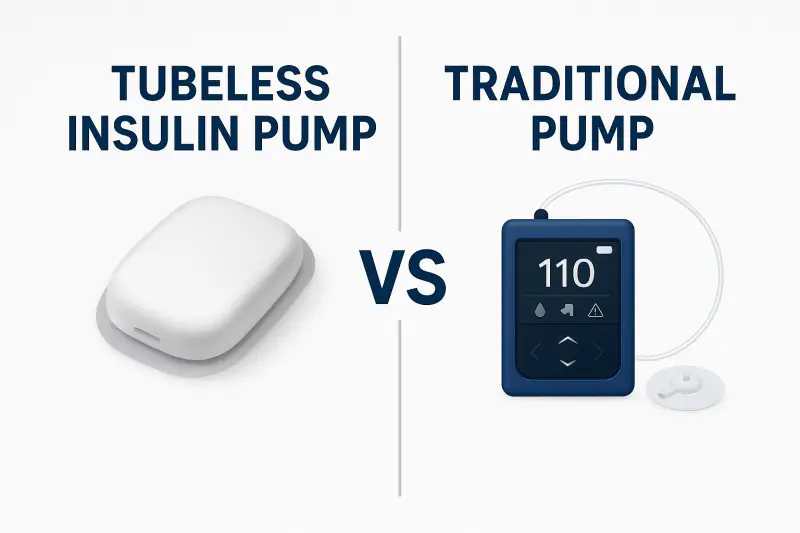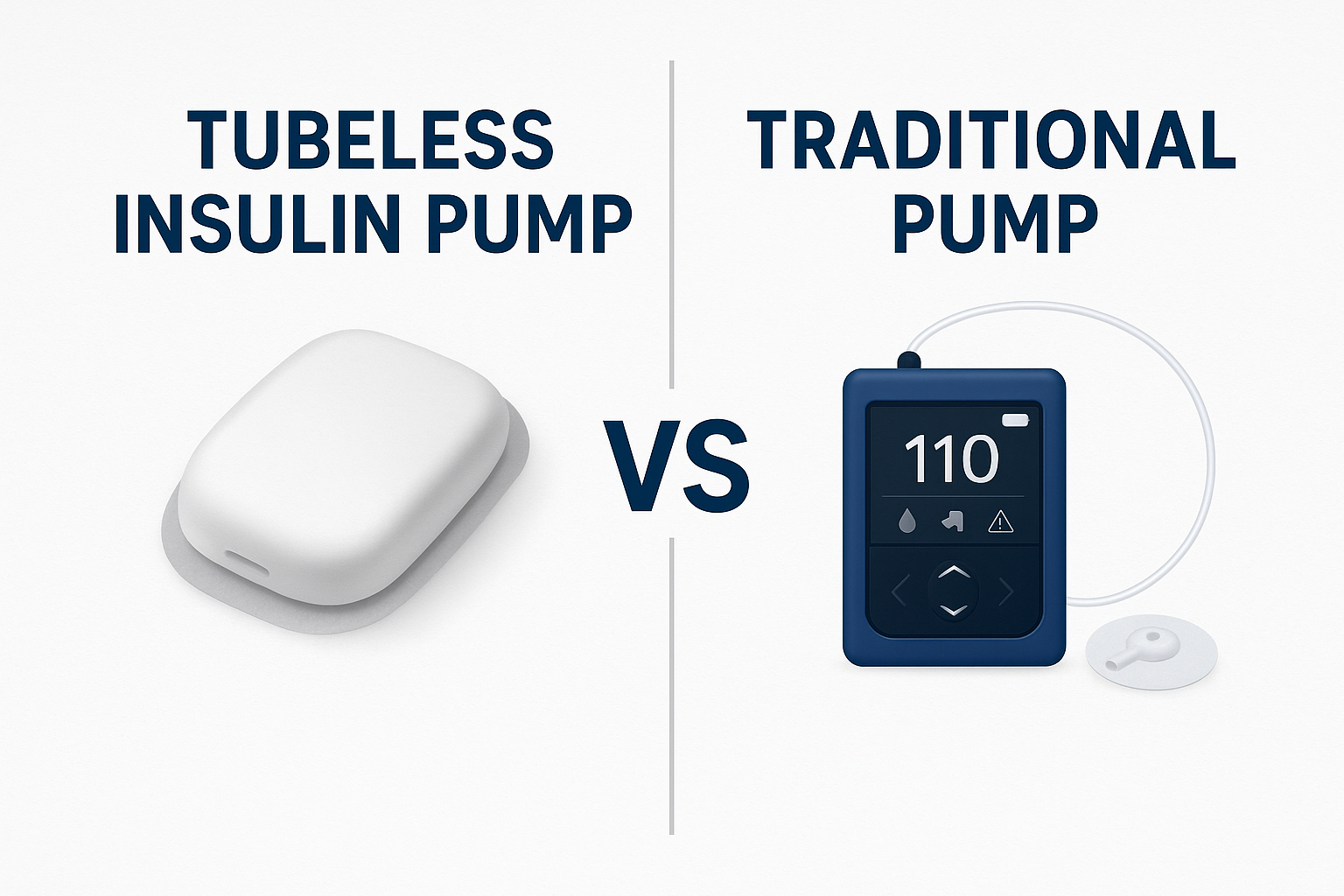For people managing diabetes, insulin delivery is one of the most important aspects of care. Over the years, technology has evolved from multiple daily injections to insulin pumps — compact, precise devices that deliver insulin automatically. Today, two major types dominate the market: tubeless (patch) insulin pumps and traditional (tubed) insulin pumps.
Both systems aim to simplify diabetes management, improve glucose control, and provide greater freedom. But which one is truly better for you? Let’s explore the key differences, benefits, and challenges of each to help you make an informed decision.
What Is an Insulin Pump?

An insulin pump is a small medical device that continuously delivers insulin through a thin tube or patch inserted under the skin. Instead of injecting insulin several times a day, you receive a steady “basal” dose and can program “bolus” doses during meals or when your blood sugar is high.
Insulin pumps closely mimic the pancreas’ natural function, offering more precise control over blood glucose levels. Many users find that pumps make managing diabetes easier and more flexible compared to traditional injections.
How Does an Insulin Pump Work?
Most insulin pumps use a reservoir filled with rapid-acting insulin. The device administers microdoses throughout the day and allows you to manually deliver extra insulin when needed. Depending on the model, the pump may connect to your body through a tubing system (traditional) or adhere directly to your skin (tubeless).
Understanding the Two Main Types of Insulin Pumps
1. Traditional (Tubed) Insulin Pumps
Traditional insulin pumps, like the Medtronic MiniMed or Tandem t:slim X2, use a small plastic tube that connects the pump to an infusion set attached to your skin. The device itself is often worn on a belt, in a pocket, or clipped to clothing.
These pumps have been around for decades and are widely trusted by healthcare professionals. They offer advanced customization, compatibility with continuous glucose monitors (CGMs), and often include automated insulin delivery systems (AID).
However, having a visible tube can feel restrictive or inconvenient for some users, especially during exercise, swimming, or sleep.
2. Tubeless (Patch) Insulin Pumps
Tubeless pumps, like the Omnipod 5, are wireless, pod-like devices that stick directly to your skin and deliver insulin without tubing. Each pod includes an integrated reservoir, cannula, and pump mechanism. The system is controlled remotely using a handheld controller or a compatible smartphone.
Tubeless pumps are small, discreet, and waterproof, making them ideal for active lifestyles. They’re especially popular among children and users who want to avoid dealing with tangled tubes.
The convenience and comfort of a tubeless system come with some trade-offs, such as limited reservoir capacity and shorter wear time compared to traditional pumps.
Comparing Tubeless vs Traditional Insulin Pumps
Ease of Use and Comfort
Tubeless insulin pumps clearly lead in terms of comfort and simplicity. You attach a pod directly to your arm, abdomen, or leg, and it delivers insulin for about 2–3 days before needing replacement. There’s no tubing to manage, and you can shower, swim, or sleep without worrying about detachment.
Traditional pumps require connecting and disconnecting tubing during certain activities. Some users find the tubes restrictive or bothersome under clothing, while others appreciate the flexibility of being able to detach the infusion set when needed.
Accuracy and Control
Traditional pumps have a long track record of precision. They offer more advanced bolus options, customizable basal rates, and integration with closed-loop systems that automatically adjust insulin delivery based on CGM readings.
Tubeless pumps are catching up fast. Newer models like Omnipod 5 now integrate with CGMs such as Dexcom G6, providing automatic adjustments and predictive algorithms that help maintain glucose stability.
Maintenance and Replacement
With traditional pumps, you refill the insulin reservoir manually, replace infusion sets every 2–3 days, and periodically change tubing. Maintenance takes more effort but allows greater control over insulin usage.
Tubeless pumps are disposable — after a pod runs out of insulin (usually 72 hours), you replace it with a new one. This simplifies maintenance but may increase long-term costs.
Design and Lifestyle Factors
Discretion and Portability
Tubeless systems are compact and nearly invisible under clothing. They’re ideal for individuals who prefer a minimalist approach. No dangling cords, no external devices — just a small patch that stays out of sight.
Traditional pumps, while slightly bulkier, offer flexibility in infusion sites and can hold larger insulin volumes, which benefits people who require higher daily doses.
Activity Level and Mobility
If you live an active lifestyle or participate in sports, a tubeless insulin pump provides greater freedom of movement. There’s no risk of tubing snagging on clothing or equipment. Swimmers and runners often find patch pumps much more practical.
However, traditional pumps can still suit active users who don’t mind securing the device in a pouch or clip. Some even prefer being able to temporarily disconnect during physical activities.
Technology Integration
Both pump types now feature Bluetooth connectivity, CGM integration, and smartphone control. Traditional pumps have led this field longer, offering more complex hybrid closed-loop options. Tubeless pumps are rapidly expanding these features, with newer versions offering real-time glucose adjustments and data sharing via mobile apps.
Cost and Insurance Considerations
Price is a crucial factor for many people. Tubeless insulin pumps typically cost more over time since each disposable pod must be replaced every few days. Meanwhile, traditional pumps have a higher upfront cost but lower long-term consumable expenses.
Insurance coverage can vary depending on your country, provider, and diabetes classification. In the United States, both types are covered under durable medical equipment (DME) plans, but some insurers may favor one brand over another. Always check with your healthcare provider and insurance company before making a decision.
Reliability and Troubleshooting
Traditional pumps are known for reliability and ease of troubleshooting. If something malfunctions, you can often identify and fix the issue without replacing the entire device.
Tubeless systems, however, may require pod replacement if an error occurs. Since pods are single-use, a faulty pod means wasted insulin and additional cost. That said, manufacturers like Insulet often replace defective pods free of charge upon request.
Safety and Risk Factors
Blockages and Site Issues
Tubed systems are slightly more prone to tubing blockages or disconnections, which can interrupt insulin delivery. Tubeless systems remove this issue entirely but may have adhesion problems if the pod doesn’t stick properly.
Both systems require careful site rotation to prevent skin irritation or infection.
Data Monitoring and Alerts
Modern pumps, both tubed and tubeless, feature real-time alerts for occlusions, low insulin levels, and connectivity issues. Tubeless systems rely on wireless communication, so maintaining signal range between the pod and controller is essential.
Comparison Table: Tubeless Insulin Pump vs Traditional Pump
| Feature | Tubeless Insulin Pump (Patch Pump) | Traditional Insulin Pump (Tubed Pump) |
|---|---|---|
| Design | Small pod worn directly on the skin, no tubing | Device connected via small plastic tube to infusion set |
| Tubing | Completely wireless, no tubes | Uses thin tubing that can tangle or detach |
| Ease of Use | Very simple to set up and replace | Requires connecting tubing and refilling reservoirs |
| Comfort | Lightweight and discreet; minimal interference | Slightly bulky; may feel restrictive for some users |
| Water Resistance | Typically waterproof (can swim/shower with it) | Usually water-resistant, must often be detached before swimming |
| Maintenance | Disposable pods replaced every 2–3 days | Tubing and infusion sets changed every 2–3 days; reservoirs refilled manually |
| Reservoir Capacity | Smaller (around 200 units of insulin) | Larger (up to 300 units of insulin) |
| Control Device | Controlled via wireless handheld device or smartphone | Buttons or touchscreen directly on the pump body |
| Integration with CGM | Supported in newer models (e.g., Omnipod 5 + Dexcom G6) | Widely supported and established with multiple CGM brands |
| Accuracy and Customization | Good, but with fewer advanced bolus options | Highly customizable basal/bolus rates and auto-adjust features |
| Lifestyle Fit | Best for active people and children; minimal hassle | Better for users who want advanced glucose control and automation |
| Reliability | Pod replacement required if error occurs | Easy to troubleshoot and fix without replacing entire device |
| Cost | Higher recurring cost due to disposable pods | Higher initial cost but lower long-term consumable costs |
| Visibility | Virtually invisible under clothing | More visible due to tubing and pump housing |
| Ideal For | Those seeking convenience, freedom, and simplicity | Those prioritizing precision, flexibility, and control |
Who Should Choose a Tubeless Insulin Pump?
Tubeless insulin pumps are perfect for people who value discretion, convenience, and an active lifestyle. They’re especially beneficial for children, athletes, and users who dislike handling tubing.
If you want a “set it and forget it” system that offers freedom of movement and simplicity, a tubeless pump might be the ideal fit — provided you’re comfortable with slightly higher ongoing costs and pod replacements.
Who Should Choose a Traditional Insulin Pump?
Traditional pumps suit users who need advanced glucose management, large insulin reservoirs, or hybrid closed-loop control. They’re ideal for individuals who want full control over every aspect of insulin delivery and don’t mind handling tubing.
These systems also tend to work better for those who require higher daily insulin doses or want to integrate with multiple CGM brands and monitoring apps.
Making the Right Choice
Deciding between a tubeless and a traditional insulin pump depends on your personal priorities — convenience, control, lifestyle, and budget all play a role. There’s no one-size-fits-all solution, and the “best” pump is the one that fits seamlessly into your daily routine.
Before choosing, talk to your endocrinologist or diabetes care specialist. Ask about trial programs, insurance coverage, and compatibility with your current glucose monitor.
FAQs About Tubeless and Traditional Insulin Pumps
Can I swim or shower with an insulin pump?
Most tubeless insulin pumps are waterproof, making them suitable for swimming and showering. Traditional pumps are typically water-resistant but should be disconnected before swimming unless specifically rated for immersion.
Do both pumps use the same type of insulin?
Yes, both systems use rapid-acting insulin analogs such as Humalog, Novolog, or Apidra.
Is a tubeless insulin pump more expensive?
Usually yes, because you replace pods every few days. Traditional pumps have higher upfront costs but lower recurring expenses.
How long does a tubeless pump last?
Each pod lasts about 72 hours, after which you replace it with a new one.
Can both pumps integrate with CGMs?
Yes. Modern models of both types can sync with popular CGMs like Dexcom and FreeStyle Libre for real-time glucose tracking.
Conclusion
Both tubeless insulin pumps and traditional insulin pumps represent remarkable progress in diabetes care. The best choice depends on your lifestyle, comfort preferences, and management goals.
If you prioritize flexibility, comfort, and simplicity, the tubeless insulin pump is a game-changer. If you prefer control, advanced features, and larger capacity, the traditional pump remains a reliable option.
Ultimately, the goal is the same: to help you live a healthier, more balanced life with better glucose control and less daily stress. With modern insulin pump technology, managing diabetes has never been more personal — or more empowering.
Disclaimer: This article is for informational and educational purposes only and should not replace professional medical advice. Always consult your doctor or certified diabetes educator before making changes to your insulin delivery method or treatment plan.



